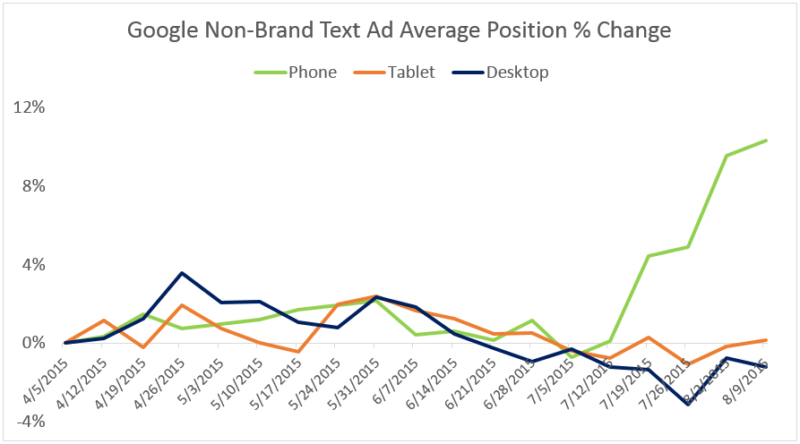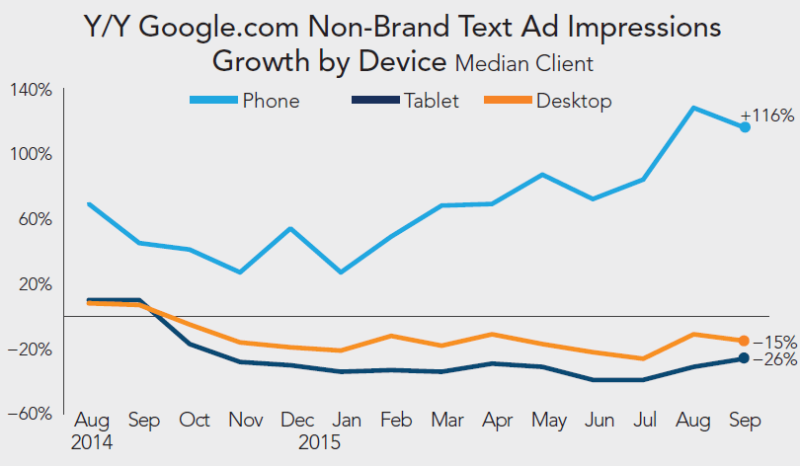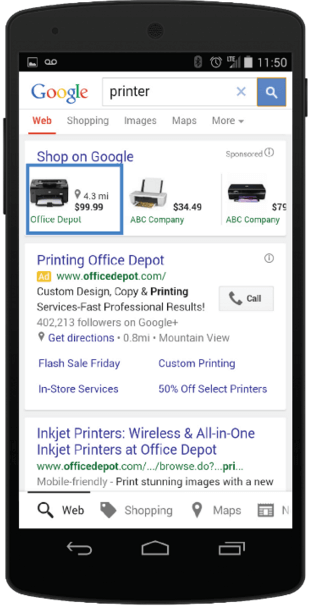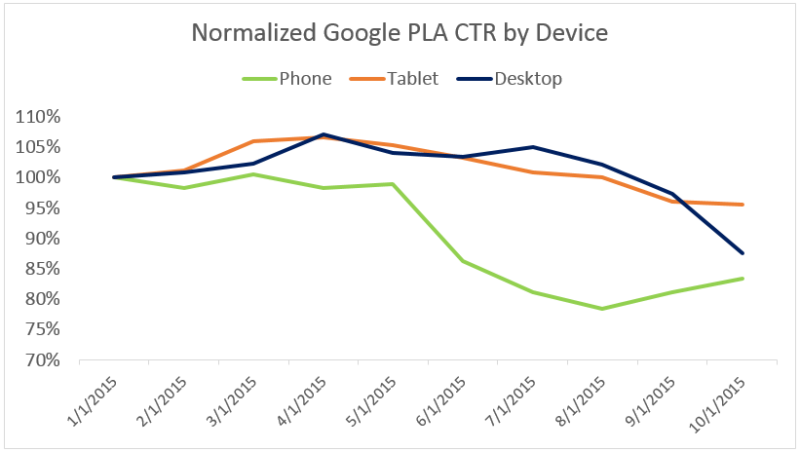
Google has made some of the biggest changes we’ve ever seen to the way it serves mobile ads over the past four months, helping to drive ad click growth up while at the same time limiting organic search visit growth.
Taken together, these updates have produced perhaps the biggest gains to Google’s mobile revenue stream ever. That’s not hyperbole — let me prove it to you.
Maximum Number Of Text Ads At The Top Of Mobile SERPs Increases 50%
As many of you probably know, Google recently began showing three text ads above the organic results for searches on phones where there used to be only two.
While Google formally announced this update in late August, hours after a column of mine outlined the apparent impact of the change, it’s clear that we began seeing text ad average position move further down the page as ads started showing lower on the page weeks earlier in July:

As a result of the additional inventory, mobile ads began getting more impressions, and year-over-year phone impression growth for non-brand text ads has been stronger over the last few months than it has been at any point in the last year.

Interesting, however, is what’s happened to click-through rate (CTR):

As you can see, non-brand text ad CTR has gone up considerably since we began seeing impression growth go up. However, with the addition of the third text ad, we would expect CTR to go down, since the likelihood of a user clicking on any individual ad should go down with more options to choose from.
So how is this possible?
One explanation is that some of the ads now getting impressions in the third spot above the organic results were already getting impressions below the organic results prior to the change. Thus, when the ads got the bump to the top of the page, the likelihood of a click went up substantially.
However, we see average position moving farther down the page, and Google is still showing ads at the bottom of the page, indicating that any ads that were moved up to the top were probably “replaced” at the bottom by additional ads. Thus, this probably isn’t causing the substantial improvement in mobile CTR we’re observing.
Rather, it’s possible that by adding a third text ad and pushing organic links even farther down the page, Google has broken the will of users who would have clicked on an organic link if they could find one at the top of the page but are instead just clicking ads because they don’t want to scroll down.
This would mean the addition of the third text ad may have pretty seriously impacted searcher behavior on phones, resulting in more ad clicks and spend headed Google’s way.
Pretty wild, but that’s not the only huge change Google has made to ads over the past few months that’s driving more mobile ad spend.
PLA Format Now Significantly Larger, But CTR Down
In early September, Google began showing PLAs (product listing ads) that are roughly double the size they were in early 2015.

This is a huge change, and it was only just over two years ago that these ads weren’t even large enough to include product title information on phones.

While Google announced earlier this year that they would be rolling out an expandable Shopping ad format which would become larger once users interacted with the carousel, reps began telling advertisers in September that the format would be larger regardless of whether or not a user interacted with the carousel.
With the much larger format, we would expect CTR to increase as PLAs now take up nearly all of the space above the fold on some phones. However, over the past few months we’ve seen declines in PLA CTR across all device types, particularly on phones.
The relative bump in PLA CTR on phones in October may have been the result of the larger format rolling out, but CTR is still down significantly compared to earlier in the year.
There appear to be a couple of changes at play here that drove CTR down.
PLAs Increasingly Showing On Search Partners With Lower CTR
The first is a recent steep rise in the share of PLA traffic that comes from Google search partners, which has been much more significant on phones and tablets than on desktop computers.
Google announced in September 2014 that Product Listing Ads would be showing more often through retail and commerce search partner sites, a practice the company began testing some time before the announcement.
However, share of PLA traffic coming from search partners was down in 2015 relative to 2014 until the recent acceleration beginning in August.

As CTR is much lower for impressions on Google search partners, the increase in the share of PLA traffic coming from Google search partners resulted in a decline in PLA CTR overall.
These search partner clicks are providing Google with additional revenue. However, the CPC (cost per click) of PLA search partner traffic on phones has declined from 98 percent that of Google.com PLA phone traffic in January to just 57 percent in October, with steep declines in relative CPC corresponding with the ramp-up in search partner traffic.

So while search partners are now garnering Google additional clicks on PLAs, those clicks come at a lower cost to advertisers.
Regardless, the increase in search partner traffic since August is clearly playing a major role in the trends we’re observing for mobile PLAs.
That increase, however, doesn’t completely explain the decline in mobile PLA CTR we have seen, which dates back to June and also occurred for Google.com traffic.
Key Metrics Suggest Google Is Showing PLAs For More Mobile Queries
The decline in Google.com mobile PLA click-through rate appears to correspond with an acceleration of impression growth on phones.

As you can see, PLA impressions increase at a far faster rate on phones than on desktop and tablet computers beginning in June, at the same time that we began seeing phone PLA CTR fall.
This doesn’t align with any announcements from Google on changes to PLAs, and it’s difficult to tell exactly how things changed.
However, the overall takeaway is that phone users have been less likely to click on Product Listing Ads since June, but the increase in the volume of PLA impressions has kept PLA phone traffic growth strong and roughly equivalent to what was observed in Q2.
And while the impact of the larger PLA format that rolled out in September may be getting cloaked under the impact of PLAs ostensibly showing more often, doubling the size of the ad should obviously increase the likelihood of clicks on these ads in the long term.
Thus, Google is now, and will likely continue, driving strong revenue growth for itself with this format on mobile devices.
Organic Search Growth Suffers
With more PLA and text ad impressions and a larger PLA format, there’s now less room for organic links to find daylight above the fold on mobile searches.
This resulted in organic search visit growth on phones declining from 51 percent in Q2 to just 20 percent in Q3.

This decline can’t be entirely attributed to monetization efforts, as not all changes impacting organic search growth led to growth in ad clicks.
For example, Google also updated its Local Pack in August to begin showing at the top of the page for a greater share of searches with local intent and searches for brands with brick-and-mortar stores. As a result, organic links moved farther down the page, and the Local Pack now provides users with local business information directly on the SERP in prime placement, reducing the need to click through to a website for some searchers.
However, the biggest drivers of the decline in Q3 organic search visit growth appear to be the ones that have directly increased Google’s ad traffic and revenue.
Conclusion
For the past few years, there have been constant rumblings about how Google would struggle with revenue generation once traffic shifted to mobile devices. However, mobile search is still clearly growing rapidly, along with mobile device usage, and Google has dialed up its monetization of mobile search in a huge way over the last four months or so.
Google basically said as much in their earnings call for Q3, at the beginning of which they stated, “The key highlight this quarter was the substantial growth of our mobile search revenue.”
As a result, advertisers need to be ready to invest even more of their paid search spend, as well as their time, analyzing and optimizing on mobile devices.
The post Google’s Efforts To Monetize Mobile Pay Off, But Sites See A Hit To Organic Visits appeared first on Search Engine Land.


No comments:
Post a Comment